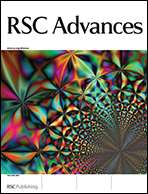Zn(ii)-doped γ-Fe2O3 single-crystalline nanoplates with high phase-transition temperature, superparamagnetic property and good photocatalytic property†
Abstract
Zn(II)-doped γ-Fe2O3 single-crystalline porous nanoplates of ca. 15 nm in thickness have been synthesized successfully via a solvothermal process combined with a post calcination process. The structure and morphology of the products were characterized by powder X-ray diffraction (XRD), differential scanning calorimetry-thermogravimetry analysis (DSC-TG), X-ray photoelectron spectroscopy (XPS), field-emission scanning electron microscopy (FESEM), and transmission electron microscopy (TEM). The results showed that nanoplates have a spindle-like morphology of ca. 200–260 nm in length and ca. 110–150 nm in width. The products showed enhanced maghemite to hematite phase transformation temperature and superparamagnetic property with high saturation magnetization, which may be attributed to the well single-crystalline structure, thin thickness and Zn(II) ion doping. Further experimental results indicated that the phase transformation temperature and the saturation magnetization of the γ-Fe2O3 nanoplates increased with the amount of doped Zn(II) ions. In addition, these nanoplates exhibited good photocatalytic activity for rhodamine B.


 Please wait while we load your content...
Please wait while we load your content...